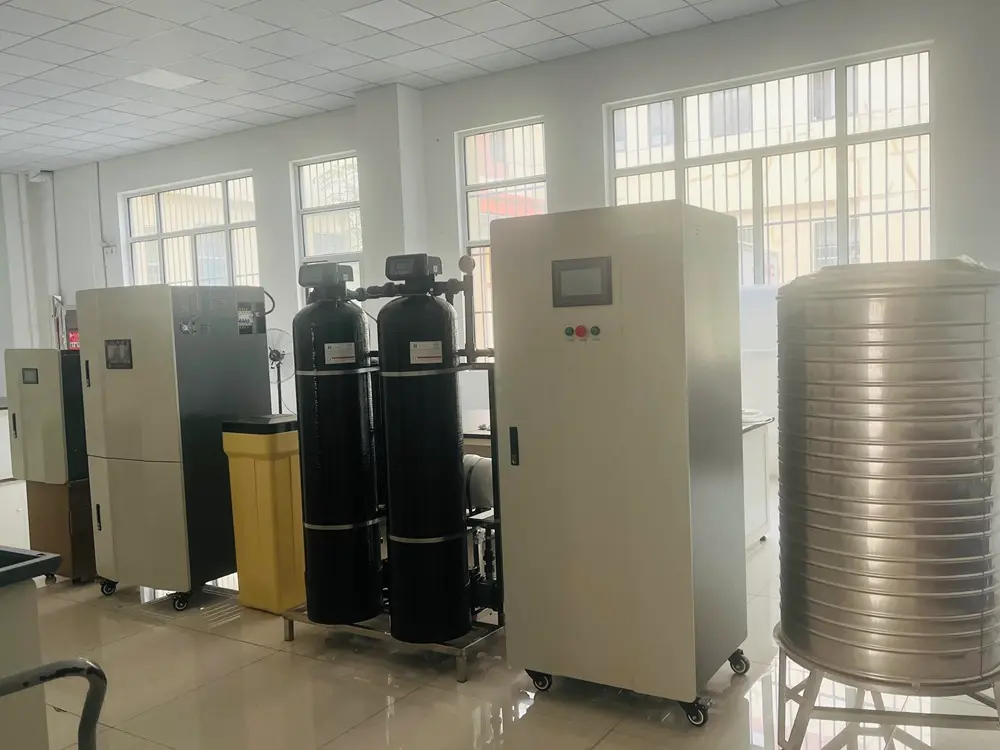In the food processing industry, preservation is a key link to ensure food safety, Hypochlorous acid generator in food is very important, the shelf life of food and maintain food quality.
Traditional preservation methods have many limitations. However, the emergence of hypochlorous acid generators has brought
new solutions for food processing and preservation, and is gradually changing the hygiene and preservation landscape of the food industry.
The working principle of hypochlorous acid generator
A hypochlorous acid generator is a device capable of preparing hypochlorous acid solution (HOCl) on site. At present,
there are two common types. One type generates hypochlorous acid solution by electrolyzing dilute hydrochloric acid,
and the other type is obtained by electrolyzing saturated brine. Take the electrolysis of saturated brine as an example.
The unit is first connected to the municipal tap water, and after passing through the built-in filter, it enters the softener to remove calcium
and magnesium ions from the water. Then, 0.3% (or 0.5%) of the saturated brine is extracted and mixed with 99.7% (or 99.5%) of the softened water,
which flows into the electrolytic cell. A series of complex chemical reactions occur during electrolysis, resulting in the primary electrolyte (Cathox solution)
and the secondary electrolyte hypochlorous acid solution (Neuthox bactericidal solution). This Neuthox bactericidal solution is a
high-concentration hypochlorous acid solution, with an effective chlorine concentration ranging from 200 to 1000ppm.
The pH value can be freely adjusted within the range of 3.0 to 8.5, and it has a high ORP value.
The sterilization principle of hypochlorous acid is unique and highly efficient. Its molecules are extremely small and uncharged,
and can easily penetrate the cell walls of bacteria. On the one hand, the (O) formed during the hydrolysis process has strong oxidizing properties,
which can denature the nucleic acids and bacterial proteins of bacteria, thereby destroying the structure and function of bacteria.
On the other hand, Cl ions can significantly alter the osmotic pressure within bacteria, rendering them inactive and achieving the purpose of sterilization.

Lorem ipsum dolor sit amet...
1. Cleaning and disinfection of fresh food: In the processing of fresh food such as fruits and vegetables, meat, and aquatic products,
hypochlorous acid generators play a significant role. For fruits and vegetables, it can effectively remove pathogenic microorganisms on the surface,
such as common pathogenic bacteria like Escherichia coli and Salmonella, and at the same time, it can also degrade some pesticide residues.
Take the processing of fresh-cut vegetables as an example. In the cleaning process, traditional sodium hypochlorite disinfection has many drawbacks.
Sodium hypochlorite disinfectant has a high concentration. If it is not cleaned thoroughly, a large amount of harmful substances will remain on the surface
of fruits and vegetables, requiring manual rinsing with a large amount of clean water. This not only wastes water resources but also increases production costs.
Moreover, it has a pungent smell and is corrosive. Improper use can affect the taste of fresh-cut fruits and vegetables and even endanger the health of employees.
When the concentration of hypochlorous acid disinfectant is (50-150 PPM), it has the characteristics of no residue, no toxicity, low odor,
and a slightly acidic pH value close to human skin. Its bactericidal effect is 80-100 times that of sodium hypochlorite. When cleaning meat and aquatic products,
hypochlorous acid can kill surface microorganisms, extend the shelf life of food, and at the same time maintain its color and flavor. After use,
it decomposes into water and trace amounts of salt, leaving no chemical residue and ensuring food safety
2: Food processing equipment and environmental disinfection: During the food processing, the hygiene of food contact equipment such as workbenches,
conveyor belts, knives, containers, as well as the environment in processing workshops and warehouses, is of vital importance.
The hypochlorous acid solution produced by the hypochlorous acid generator can be used for disinfection of these devices and the environment.
When disinfecting equipment, hypochlorous acid can quickly kill bacteria, viruses and fungi, prevent cross-contamination of microorganisms,
and food does not need to be rinsed after processing, avoiding secondary contamination. When used for air disinfection,
it can effectively kill bacteria and viruses in the air and improve the production environment. In low-temperature environments
such as cold chain transportation vehicles and cold storage rooms, hypochlorous acid can also effectively control the growth of microorganisms,
ensuring the safety of food during transportation and storage.
3: Preservation and extended shelf life: Hypochlorous acid has a remarkable effect in food preservation. In the preservation of fruits and vegetables,
it can be combined with controlled atmosphere storage preservation technology. For instance, research has found that
using 60ppm hypochlorous acid combined with modified atmosphere packaging (5% oxygen and 10% carbon dioxide)
can effectively maintain the sensory quality of fresh-cut lettuce and extend its shelf life. Hypochlorous acid kills or
controls pathogenic microorganisms on the surface or inside fruits and vegetables, and regulates the post-harvest respiratory metabolism of fruits and vegetables.
It forms a synergistic effect with the regulation of environmental gas composition in controlled atmosphere storage, ensuring the freshness of
fruits and vegetables in multiple aspects and reducing the spoilage rate. For other foods such as meat, hypochlorous acid
can also inhibit the growth of microorganisms, delay food spoilage and extend their sales time in the market.

The advantages and benefits of applying hypochlorous acid generators
1:Highly efficient sterilization, ensuring safety: Hypochlorous acid has a rapid killing effect on various microorganisms,
effectively eliminating harmful microorganisms on the surface of food and in the processing environment,
significantly reducing food safety risks and safeguarding consumers’ health. Its broad-spectrum bactericidal effect and high
efficiency are incomparable to those of some traditional disinfectants, providing more reliable hygiene guarantees for food processing enterprises.
2: Environmentally friendly and residue-free: After use, hypochlorous acid decomposes into water and trace amounts of salt,
leaving no harmful residues. It does not cause pollution to the environment and does not leave any chemical substances in food,
meeting the strict requirements of current green production and food safety. This enables food processing enterprises to produce safer and healthier food while meeting environmental protection regulations.
3: Significant cost-effectiveness: Although the initial purchase of a hypochlorous acid generator incurs certain costs,
in the long run, its operating costs are lower compare to commercially available disinfectants. In the processing of fresh-cut vegetables and other links,
the large amount of rinsing water cause by the residue of traditional disinfectants has been reduced, saving water resources and labor costs.
Meanwhile, the characteristic of hypochlorous acid in extending the shelf life of food reduces the loss caused by food spoilage and
improves the economic benefits of enterprises.

FAQ
What concentration is needed for cleaning and disinfecting utensils in food processing
The disinfection concentration range of hypochlorous acid for utensils is generally between 50 and 100PPM
Can hypochlorous acid generators corrode mechanical equipment?
Hypochlorous acid is non-corrosive to metals. Hypochlorous acid with a PH value of 5 to 6.5 is classified as a weak acid.
Does the hypochlorous acid generator have a preservative effect on meat?
Yes, hypochlorous acid can extend the preservation time of meat
